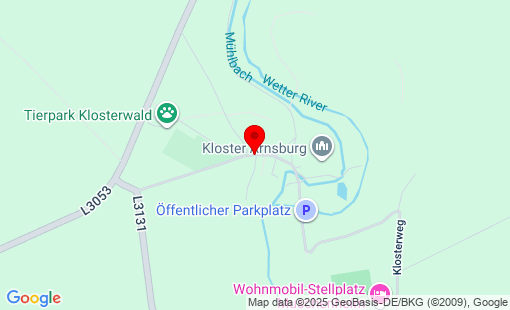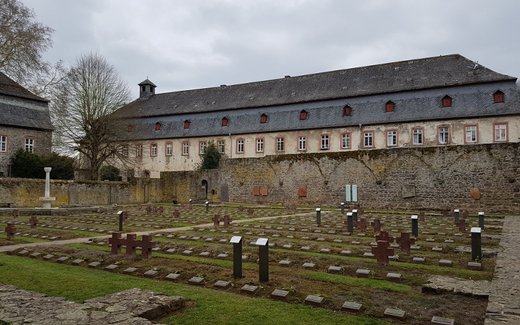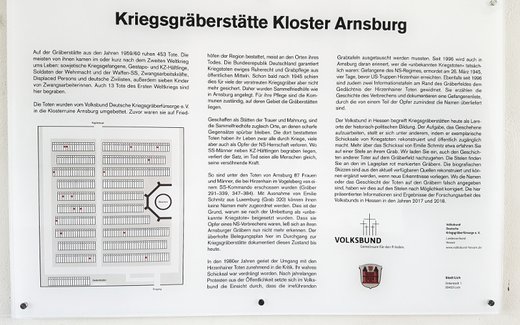The cemetery from 1959/60 is home to 453 dead. Most of them
died during or shortly after the Second World War: Soviet prisoners of war, Gestapo
Prisoners of war, Gestapo and concentration camp prisoners, Wehrmacht and Waffen-SS soldiers
Waffen-SS, forced laborers, displaced persons and German civilians,
as well as seven children of forced laborers. There are also 13 dead from the First
World War I are also buried here.
The Volksbund Deutsche Kriegsgräberfürsorge e.V. (German War Graves Commission) moved the dead to the
Arnsburg monastery ruins. Previously, they were buried in cemeteries in the region
mostly in the places where they died. The Federal Republic of Germany
guarantees war dead perpetual rest and grave care from public funds
Public funds. Soon after 1945, however, this no longer seemed guaranteed for many of the scattered
Scattered war graves. For this reason, collective cemeteries such as
Arnsburg were established. The municipalities on whose territory the gravesites are
The cemeteries are located.
Created as places of mourning and remembrance, the collective cemeteries are also
are also places where sharp contrasts remain tangible. The dead buried there
buried there all lost their lives in wars, but many also as victims of
Victims of Nazi rule. Where SS men are buried next to concentration camp prisoners
prisoners, the sentence that all people are equal in death loses its reconciling power
Power.
The dead of Arnsburg include 87 men and women who were killed by an SS commander near Hirzenhain
in the Vogelsberg by an SS commando (graves 291-339,
347-384). With the exception of Emilie Schmitz from Luxembourg (grave 320), no names can be
names can no longer be assigned to them. This is the reason why, after the
Reburied as "unknown war dead". The fact that they were victims of a
Nazi crimes could no longer be recognized on their Arnsburg graves
recognize. The outdated burial plan in the passageway to the war cemetery
documents this situation to this day.
In the 1980s, the treatment of the Hirzenhain dead came under increasing criticism
criticism. Their true fate had been suppressed. After years of
Years of protests from the public, the Volksbund came to the realization
that the misleading grave plaques had to be replaced. Since 1996
arnsburg has also been reminding people who the "unknown war dead" actually
were: Prisoners of the Nazi regime, murdered on March 26, 1945, four days before
US troops reached Hirzenhain. Since 1996, there have also been two
Information boards at the edge of the cemetery have been dedicated to the memory of the Hirzenhain
Dead. They tell the story of the crime and document a list of prisoners
prisoner list, through which at least the names of some of the victims have been
have been handed down.
Today, the Volksbund in Hesse regards war cemeteries as places of learning for historical and
historical and political education. The task of coming to terms with what happened,
the task of coming to terms with what happened by, among other things, reconstructing exemplary fates of war dead
and making them accessible to the public. You can find out more about the fate of
Emilie Schmitz on a stele at her grave. We invite you
to follow the stories of other dead on the cemetery. In the
Passageway to the cemetery is a new information board with a map
Map. The graves where stelae have been erected are marked with red dots
Marked with red dots. The biographical sketches have been reconstructed from currently available
Reconstructed from currently available sources and can be added to if new
become available. Where the names or gender of the deceased are incorrect on the graves, this has been
on the graves, this has been corrected on the steles where possible. The
information presented was compiled in 2017 and 2018 in the research project on the
History of the Hessian war cemeteries, which was initiated by the Volksbund in
Hesse launched in 1999.
Some of the 87 people murdered in Hirzenhain had already been in the local
"labor education camp" or "extended women's prison" run by the Frankfurt
Gestapo, which was attached to the Breuer-Werke, an armaments factory
was attached to the Breuer-Werke, an arms factory. Other women imprisoned by the Gestapo were released on March 23, 1945 when the
The approach of the US Army from the Frankfurt police prison to Hirzenhain
when the US army approached. Under the pretext of being released, they were marched on March 26
and shot in a pit a short distance from the camp.
In May 1945, 87 bodies were recovered from the mass grave and first buried in the Hirzenhain cemetery
Hirzenhain cemetery and then, on the orders of the American military government
at a memorial site set up centrally in the town. in 1947, the
Sister of one of the victims was able to identify the perpetrators from the SS and Gestapo.
The commander of the shooting pit, SS-Hauptscharführer Emil Fritsch,
was the only one of those involved to be brought to trial in 1951 and
sentenced to life imprisonment. He died in prison in 1959.
The first plaque commemorating the victims of Hirzenhain, which was erected in 1996 at
Arnsburg monastery in 1996, listed the number of murdered victims as
81 women and six men. This ratio was also used by the district court
Giessen when it sentenced the commander of the shooting pit to life imprisonment in 1951
life imprisonment in 1951. Since then, almost all sources of information
these figures. An eyewitness had testified a few days after the opening of the
Shooting pit had testified that there were "10-15" male corpses in it,
but another witness was believed in the preliminary proceedings who
only remembered six men two years later.
When the relevant historical documents were analyzed again in 2017 in the research project of the
Volksbund's research project in Hesse in 2017, however, it emerged that
76 women and eleven men had actually been shot. Therefore, the
Text of the memorial plaques from 1996 was revised and supplemented. Two new plaques made of
Glass plaques have replaced the old ones since 2019, which had also been severely
had aged due to the weather.
A stele at the grave of one of the murdered men also takes up the theme of the
Ratio is also addressed. It names the origin of the incorrect
And describes how this became established in the historical tradition
established in historical tradition.
Germany
Lich-Arnsburg
Total Occupation: 446 fatalities
Total Occupation: 446 fatalities
Contact


